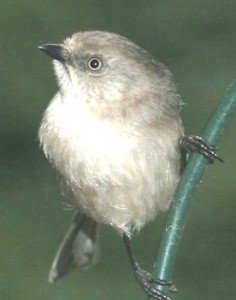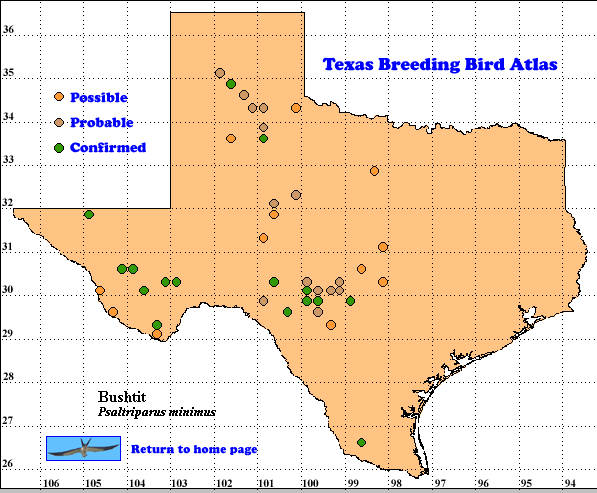Bushtit is a combination of two former species, Common or Lead-colored and Black-eared bushtits. In Texas first-year males in some areas show the facial plumage which once defined the black-eared form (Lockwood and Freeman 2004). The American Ornithologists” Union considers Bushtit to be composed of three groups: one in the mountains of the Pacific Coast from southern British Columbia to Baja California, another in the interior western United States and a third in the highlands of mainland Mexico and Guatemala (Am. Ornithol. Union 1998). Further study is needed to define boundaries between the groups. Plumage and behavioral differences between the first two groups have been documented (Sloane 2001).
This small, social bird is usually found in flocks of 10-40 individuals who defend a flock territory. Bushtits on the West Coast have not been observed using nest helpers in their usual live oak habitat. In contrasts n southern Arizona as many as 39% of pairs have the assistance of as many as 4 helpers, mostly males who help with incubation, feeding and brooding duties (Sloane 2001).
DISTRIBUTION. During the 1987-1992 field work seasons of the TBBA project, atlasers found confirmed breeding evidence for Bushtits mostly in the Trans-Pecos, Edwards Plateau and Rolling Plains regions (see the region map in Lockwood and Freeman [2004]). Data from 12 North American Breeding Bird Survey routes in Texas suggests only the Edwards Plateau and the area around the Guadalupe Mountains had relative abundances as high as 1-3 Bushtits per route. The general shape of the BBS map approximates the TBBA map (Sauer et al. 2005).
The BBS map indicates most Bushtits are found in the coast ranges of British Columbia, Washington and Oregon and all ranges of California and northern Baja California. Bushtits are found at relative abundances less than one in the interior of Oregon, southern Idaho, Nevada, Utah and Colorado and as high as 3-10 per route in Arizona and New Mexico (Sauer et al. 2005). The range continues south though the highlands of mainland Mexico to the Isthmus of Tehuantepec with other populations in the highlands of Chiapas, Mexico and Guatemala (Howell and Webb 1995).
SEASONAL OCCURRENCE. The Bushtit is a year-round resident within its range. Bushtits breed from mid-March to late June in Texas, based on egg dates from March 26 to June 13 and TBBA data (Oberholser 1974). TBBA observers found recently fledged young at 2 sites on April 30 and May 2. In Arizona where the breeding population is larger than in Texas, observers found breeding evidence as late as late July (Wise-Gervais 2005).
BREEDING HABITAT. Bushtits breed in Texas between 170 and 2600 m (550-8500 ft). They reside in scrub oaks and cedars on the Edwards Plateau and in canyons on the Panhandle. In the Trans-Pecos mountains, they breed in habitats containing trees such as madrone, oak, juniper, pinyon and ponderosa pines (Oberholser 1974). In Arizona about 43% of breeding evidence was found in pinyon-juniper woodland, 11% in evergreen oaks and 10% in shrub oak mixed with other shrubs (Wise-Gervais 2005). In Colorado about 70% of breeding records came from pinyon-juniper and 10% came from shrub oak habitats (Dexter 1998).
The nest, a long (15-30 cm [6-12 in])), loose sack built by the pair in 13-51 days, is 2-11 m (6-35 ft) above ground. They use various vegetative materials held together with spider silk. It is attached to a fork of a small branch or two pieces of adjacent vegetation in a tree of shrub. A side opening near the top provides access to the nest which is lined with plant down, hair and feathers (Harrison 1979, Sloane 2001).
The female usually lays about 6 (range 4-10) white eggs which both sexes and possibly helpers incubate for 12-13 days. Young birds depart the nest 18 days after hatching, fully capable of flight. Some pairs start another brood as soon as the young fledge, leaving their care to helpers. Bushtits are rarely parasitized by Brown-headed Cowbirds (Molothrus ater; Harrison 1979, Sloan 2001).
STATUS. Bushtits are uncommon to common residents of the Panhandle, Edwards Plateau and Trans-Pecos regions of Texas (Lockwood and Freeman 2004). BBS data from Texas are inadequate to provide biologically meaningful population trends for the periods 1966-2005 and 1980-2005. In the western United States and southwestern Canada 277 routes provide a statistically significant population trend of -2.8% per year for the period 1980-2005. This disappointing figure may primarily reflect conditions on the Pacific Coast where California with 126 routes and Washington with 14 produced statistically significant population trends of -3.2% and -13.9% respectively (Sauer et al. 2005).
Text by Robert C. Tweit (2006)
Literature cited.
American Ornithologists’ Union. 1998. Checklist of North American birds, 7th ed. Am, Ornithol. Union, Washington, DC.
Dexter, C. 1998. Bushtit (Psaltriparus minimus). In Colorado breeding bird atlas, pp. 354-355 (H. E. Kingery, ed.). Colorado Bird Atlas Partnership, Denver.
Harrison, H. H. 1979. A field guide to western birds’ nests. Houghton Mifflin, Boston, MA.
Howell, S. N. G. and S. Webb. 1995. A guide to the birds of Mexico and northern Central America. Oxford University Press, New York.
Lockwood, M. W. and B. Freeman. 2004. The TOS handbook of Texas birds. Texas A&M University Press, College Station.
Oberholser, H. C. 1974. The bird life of Texas. University of Texas Press, Austin.
Sauer, J. R., J. E. Hines, and J. Fallon. 2005. The North American Breeding Bird Survey, results and analysis 1966-2005. Version 6.2 2006. USGS Patuxent Wildlife Research Center, Laurel MD < http://www.mbr-pwrc.usgs.gov/bbs>
Sloane, S. A. 2001. Bushtit (Psaltriparus minimus). In The birds of North America, No. 598 (A. Poole and F. Gill, eds.). The Birds of North America, Inc., Philadelphia, PA.
Wise-Gervais, C . 2005. Bushtit (Psaltriparus minimus). In Arizona breeding bird atlas. pp. 392-393 (T. E. Corman and C. Wise-Gervais, eds.). University of New Mexico Press, Albuquerque.

